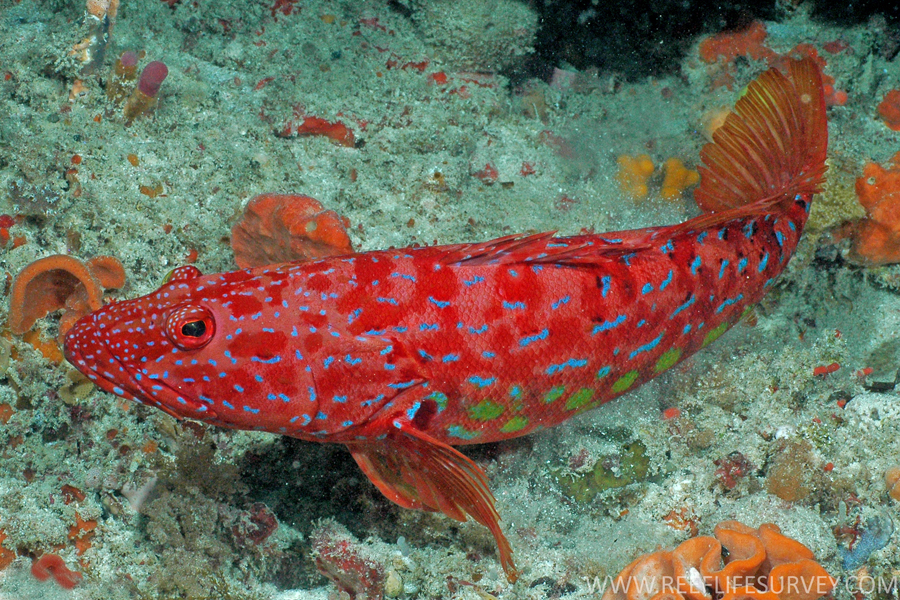Harlequin Fish, Othos dentex (Cuvier 1828)
Other Names: Chinese Lantern, Harlequin Cod, Harlequin Rock Cod, Harlequinfish, Tiger Cod

A Harlequin Fish, Othos dentex, in Jurien Bay, Western Australia. Source: Graham Edgar / Reef Life Survey. License: CC BY Attribution
Summary:
A large colourful cod found only in South Australia and Western Australia to the Houtman Abrolhos. Although Harlequin Fish historically occurred in Victoria, including in Port Phillip Bay, they are now absent from Victorian waters.
Harlequin Fish vary greatly in colour, ranging from orange, to pinkish, reddish, green or brown, with large yellow, greenish, or brilliant blue spots and dashes, and a large red blotch behind the pectoral-fin base. They also have enormous canine teeth at the front of the jaws that are visible when the mouth is closed.
Video of a Harlequinfish on Port Noarlunga Reef, South Australia.
Video of a Harlequinfish off Bunbury, Western Australia - about 27 seconds into the video.
Harlequin Fish vary greatly in colour, ranging from orange, to pinkish, reddish, green or brown, with large yellow, greenish, or brilliant blue spots and dashes, and a large red blotch behind the pectoral-fin base. They also have enormous canine teeth at the front of the jaws that are visible when the mouth is closed.
Video of a Harlequinfish on Port Noarlunga Reef, South Australia.
Video of a Harlequinfish off Bunbury, Western Australia - about 27 seconds into the video.
Cite this page as:
Bray, D.J. 2020, Othos dentex in Fishes of Australia, accessed 27 Jun 2025, https://fishesofaustralia.net.au/Home/species/4383
Harlequin Fish, Othos dentex (Cuvier 1828)
More Info
|
Distribution |
Port Phillip Bay, Victoria, to the Houtman Abrolhos, Western Australia - although the species has not been seen in Victoria in recent times. Inhabits exposed coastal reefs, drop-offs and caves in depths to 30 metres, and are active during the daytime. They are a long-lived site-attached species with a relatively small home range. |
|
Features |
Dorsal fin X, 18; Anal fin III, 8; Caudal fin 17; Pectoral fin 15; Pelvic fin I, 5; Lateral line 81-87 Body long, moderately slender, head large, dorsal profile slightly convex, hind margin of gill cover with a pointed flap and three spines, eyes on top of head. Mouth large, extending beyond eye, front of jaws with enormous canine teeth visible when mouth closed. |
|
Colour |
Highly variable in coloration: including orange, pink green, brown and red above with a greyish underside, large yellow to green or bright blue spots below, blue dashes or dots on head and upper body, and a large red blotch at pectoral-fin base. The large spots on the lower sides are yellow to juveniles and females. As males mature, the spots as males become mature, the spots become green, before finally changing to bright blue. The blue spots and dashes become more prominent in males and intensify in colour during the spawning period. |
|
Feeding |
An ambush predator that feeds mostly on small fishes. |
|
Biology |
Unlike many species in the Family Serranidae which are hermaphrodites, Harlequin Fish are gonochorists with the sexes separate. French et al. (2014) found that the gonads of each fish examined contained solely ovarian tissue or testicular tissue. Spawning occurs from September to March. Individuals begin to mature at four years of age, and some do not mature until their 10th year. Females grow slightly larger than males and live to at least 42 years. |
|
Fisheries |
Not targeted by commercial fishers, although taken as by-catch in temperate Demersal Gillnet and Demersal Longline Fisheries. This species is also taken as by-catch in the West Coast Demersal Scalefish, and in rock lobster pots. Also targeted by recreational line fishers and spear fishers. |
|
Species Citation |
Plectropoma dentex Cuvier, G.L. in Cuvier, G.L. & Valenciennes, A. 1828. Histoire Naturelle des Poissons 2: 394. Type locality: King George Sound, Western Australia. |
|
Author |
Bray, D.J. 2020 |
|
Resources |







